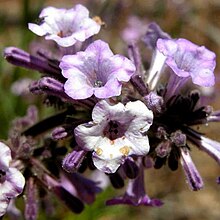Turricula (plant)
| Eriodictyon parryi | |
|---|---|
 |
|
| Scientific classification | |
| Kingdom: | Plantae |
| (unranked): | Angiosperms |
| (unranked): | Eudicots |
| (unranked): | Asterids |
| Order: | (unplaced) |
| Family: | Boraginaceae |
| Subfamily: | Hydrophylloideae |
| Genus: | Eriodictyon |
| Species: | E. parryi |
| Binomial name | |
|
Eriodictyon parryi (A.Gray) Greene |
|
| Synonyms | |
|
|
Eriodictyon parryi or poodle-dog bush is a tall California mountain shrub with showy purple flowers, which is notable for secreting a severe skin irritant.
The plant is endemic to southern California and Baja California. It is particularly common in the Transverse Ranges, and also occurs in the Coast Ranges south of San Luis Obispo, and in the Sierra Nevada as far north as Kings Canyon.
It is found in chaparral, on granitic slopes and ridges from 1,000 to 2,300 metres (3,300 to 7,500 ft). It thrives in areas of yellow pine forest that have been recently disturbed by fire or landslides, where it helps to prevent erosion and can cover burned hillsides with attractive color. The plant often remains dominant in such areas for about ten years until saplings and other plants fill back in and outcompete it. Its seeds can then remain dormant in soil for long periods, with the plant springing back up quickly at the next disturbance.
Presumably because of its irritant properties, poodle-dog bush is rarely grown in gardens despite its attractive flowers, and it is difficult to grow in garden conditions.
It grows into a moderate size, perennial woody shrub, branching from the base but with main stems extending for up to 2 meters. Is leaves are long and narrow, and may be toothed at the edge; they can be from 4 to 30 centimetres (1.6 to 11.8 in) long. It flowers from June to August, having clusters (cymes) of attractive bell-shaped blue, lavender or purple flowers. However it has a rank smell. Its flower clusters and hairy stem are similar to those of many plants in the genus Phacelia, but it can be distinguished from them by its greater height.
When first described by Asa Gray, the poodle-dog bush was placed within the genus Nama. It was subsequently moved to a monotypic genus Turricula (having the same name as a genus of sea snails). Molecular phylogenetic analysis carried out by Ferguson (1998) supports treating Turricula as a separate genus within a clade (Ferguson does not use the term "subfamily") that includes Eriodictyon, and also the genera Nama and Wigandia. However, other molecular data support placing the plant in Eriodictyon.
...
Wikipedia
